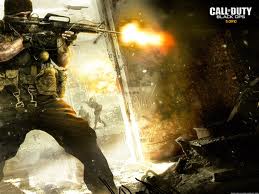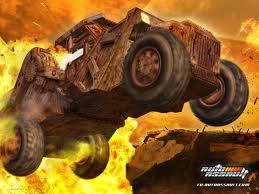26 posts
• Page 1 of 2 • 1, 2
Any one else hoping for an improvement in the combat system
-

brandon frier - Posts: 3422
- Joined: Wed Oct 17, 2007 8:47 pm
Considering how sword fighting is one of the main gameplay elements in TES for most people (pure magic users excluded of course) I woudl expect them to really overhaul the current system. They have some great ideas in current mods to give them a starting point.
-

Kara Payne - Posts: 3415
- Joined: Thu Oct 26, 2006 12:47 am
Locational damage - promising seen as Fallout 3 had it
Damage threshold - IMO makes even more sense to use it in Skyrim than it did to use it in New Vegas. Why is this man doing damage to me? How can his fists hurt me at all when I'm wearing steel plate armour?
Less staggering - if I'm charging forward at 15 miles an hour with a 20 pound warhammer in full swing a puny arrow hitting me in the arm would not instantly cause me to stop and then start staggering backwards
Better ragdolls - less dead people floating to the ground like they're made of foam
Momentum - ala Mount & Blade
Damage threshold - IMO makes even more sense to use it in Skyrim than it did to use it in New Vegas. Why is this man doing damage to me? How can his fists hurt me at all when I'm wearing steel plate armour?
Less staggering - if I'm charging forward at 15 miles an hour with a 20 pound warhammer in full swing a puny arrow hitting me in the arm would not instantly cause me to stop and then start staggering backwards
Better ragdolls - less dead people floating to the ground like they're made of foam
Momentum - ala Mount & Blade
-

Alyce Argabright - Posts: 3403
- Joined: Mon Aug 20, 2007 8:11 pm
Yes,
I want it to go back to MW's style. I'm more like Daffy's Robin Hood with these madern tachniques. Just let me click and let the computer do the die roll. :thumbsup:
I want it to go back to MW's style. I'm more like Daffy's Robin Hood with these madern tachniques. Just let me click and let the computer do the die roll. :thumbsup:
-

Tiffany Castillo - Posts: 3429
- Joined: Mon Oct 22, 2007 7:09 am
Also Running, if i see an enemy im going to charge him.
and when you kill some one they need a dieing animation, like where they fall to their knees, and that is where you proceed to hack off their had
that being said, the ability to mutilate bodes, but no as gorey as fallout. I should not think of fallout when im playing TES
and when you kill some one they need a dieing animation, like where they fall to their knees, and that is where you proceed to hack off their had
that being said, the ability to mutilate bodes, but no as gorey as fallout. I should not think of fallout when im playing TES
-

Taylrea Teodor - Posts: 3378
- Joined: Sat Nov 18, 2006 12:20 am
going back to what i said earlier, maybe there should be a system where if you hit an enemy enough time with detect hits, you could build up momentum, or rage, and then let out a combo, that could be deadly. And if you failed the button combo you would suffer from a counter attack
-

luis ortiz - Posts: 3355
- Joined: Sun Oct 07, 2007 8:21 pm
the ability to mutilate bodes, but no as gorey as fallout
Why not? If some moron is foolish enough to bother me whilst I'm out on my evening stroll I want to break his face, stab him in the chest, reach in, rip the still beating heart out and show it to him, watch him die in agony, chop his corpse into pieces, put his head on a pike and then make a cloak out of his skin
That'll teach em
-

Matt Terry - Posts: 3453
- Joined: Sun May 13, 2007 10:58 am
Yes, I want to see an improvement. Oblivion's combat system was a lot better then Morrowind's, but it still lacked some depth. Maybe something like Dark Messiah Might and Magic would be a good template for what combat should be like.
-

luis ortiz - Posts: 3355
- Joined: Sun Oct 07, 2007 8:21 pm
@ Mish - I agree with most of what you said, hoever, you'd be surprised at your change in momentum if charging at an enemy and then caught on the flanks (especially say the arm or upper shoulder) with an arrow. While you won't go "flying backwards, it's almost a given that you'll stumble and inevitably fall.
In terms of physics think of it like how NASA works on deflecting earth killer asteroid from, well, killing us all. There's no drill a hole drop a nuke, it's more small impacts to the side, enough to divert course and miss us. Just as an arrow would divert your course if you were charging an enemy line. If you somehow don't manage to faceplant into the ground you most assurdly won't hit the same point in which you were targeting.
@ Dark - I especially like Dark Messiah's stealth kills, nothing quite compares to jabbing a knife in an enemy throat, pulling it towards you and ripping it out. One of the cooler aspects of that game if you ask me.
In terms of physics think of it like how NASA works on deflecting earth killer asteroid from, well, killing us all. There's no drill a hole drop a nuke, it's more small impacts to the side, enough to divert course and miss us. Just as an arrow would divert your course if you were charging an enemy line. If you somehow don't manage to faceplant into the ground you most assurdly won't hit the same point in which you were targeting.
@ Dark - I especially like Dark Messiah's stealth kills, nothing quite compares to jabbing a knife in an enemy throat, pulling it towards you and ripping it out. One of the cooler aspects of that game if you ask me.
-

herrade - Posts: 3469
- Joined: Thu Apr 05, 2007 1:09 pm
ok just saw dark messiah, that looks like exactly what i want
-

Jynx Anthropic - Posts: 3352
- Joined: Fri Sep 08, 2006 9:36 pm
Just don't make it like OBs. Bores me everytime I play it now. *Swing sword* *Swing sword* *Block* *Swing sword* *Block*
-

Daniel Lozano - Posts: 3452
- Joined: Fri Aug 24, 2007 7:42 am
I think armor should actually show that it protects you, like arrows that are not strong enough will simply bounce off doing minor damage...
Also they should take some stuff from Fallout like dismemberment and damage to limbs causing them run slower or use weapons poorly
getting hit in a area where you are not protected by armor should do normal damage as well... really just some common sense here =/
Also they should take some stuff from Fallout like dismemberment and damage to limbs causing them run slower or use weapons poorly
getting hit in a area where you are not protected by armor should do normal damage as well... really just some common sense here =/
-

Heather M - Posts: 3487
- Joined: Mon Aug 27, 2007 5:40 am
@ Mish - I agree with most of what you said, hoever, you'd be surprised at your change in momentum if charging at an enemy and then caught on the flanks (especially say the arm or upper shoulder) with an arrow. While you won't go "flying backwards, it's almost a given that you'll stumble and inevitably fall.
In terms of physics think of it like how NASA works on deflecting earth killer asteroid from, well, killing us all. There's no drill a hole drop a nuke, it's more small impacts to the side, enough to divert course and miss us. Just as an arrow would divert your course if you were charging an enemy line. If you somehow don't manage to faceplant into the ground you most assurdly won't hit the same point in which you were targeting.
In terms of physics think of it like how NASA works on deflecting earth killer asteroid from, well, killing us all. There's no drill a hole drop a nuke, it's more small impacts to the side, enough to divert course and miss us. Just as an arrow would divert your course if you were charging an enemy line. If you somehow don't manage to faceplant into the ground you most assurdly won't hit the same point in which you were targeting.
Err... that greatly depends on the profile of the arrow, the angle of impact, and exactly how big the attacker is. I think in many cases you'll find this is not the case. Arrows are built to penetrate, which by definition means they don't transfer much of their momentum on impact. It's dissipated by friction against internal tissues, converting much of the vector to heat -- and we're only talking about 15 joules or so. Mishaxhi's hammer example is 600 just for the hammer, never mind the momentum of the guy wielding it, and the likelihood that he's in plate armor (which may increase the momentum transfer of the arrow somewhat, but also greatly increases the momentum of the wearer).
And you don't have to hit exactly where you were aiming to do a lot of damage with a sledge.
-

Veronica Martinez - Posts: 3498
- Joined: Tue Jun 20, 2006 9:43 am
I wouldn't change anything from Oblivions combat system as I thought they nailed it Perfectly.
-

Tracy Byworth - Posts: 3403
- Joined: Sun Jul 02, 2006 10:09 pm
I wouldn't change anything from Oblivions combat system as I thought they nailed it Perfectly.
In what way is it "perfect"?
-

jess hughes - Posts: 3382
- Joined: Tue Oct 24, 2006 8:10 pm
Err... that greatly depends on the profile of the arrow, the angle of impact, and exactly how big the attacker is. I think in many cases you'll find this is not the case. Arrows are built to penetrate, which by definition means they don't transfer much of their momentum on impact. It's dissipated by friction against internal tissues, converting much of the vector to heat -- and we're only talking about 15 joules or so. Mishaxhi's hammer example is 600 just for the hammer, never mind the momentum of the guy wielding it, and the likelihood that he's in plate armor (which may increase the momentum transfer of the arrow somewhat, but also greatly increases the momentum of the wearer).
And you don't have to hit exactly where you were aiming to do a lot of damage with a sledge.
And you don't have to hit exactly where you were aiming to do a lot of damage with a sledge.
Point taken, but perhaps you miss the point of what I was saying (don't mean that condescendingly if it appeared that way)
I don't need the arrow to transfer a whole lot of energy, in fact I don't need the arrow to transfer even half the energy it has in ordger to stagger you. If you're running at me full speed and I throw a rock at you that hits center mass,.. sure, your speed may slow by a fraction but you'll still be coming at me close to the same speed. If I throw the same rock, and I hit you on the shoulder with the same force, while I'll conceed you may not fall, your momentum will shift and you'll definately stumble. It's as simple as Newton's laws, If I wanted to stop you I would need to exact the same amount of force that you are producing by charging towards me, if I want to divert you, I only need to apply minimal force to change your trajectory.
You see this in many things.. American football, soccer, kung fu to name a few.
Sure it doesn't take much for a guy with a big hammer to do damage, the reverse is true as well. If I catch said guy with a big hammer in plate mail soon enough, it doesn't take much to divert him either.
-

Far'ed K.G.h.m - Posts: 3464
- Joined: Sat Jul 14, 2007 11:03 pm
In what way is it "perfect"?
The flow of Combat, The Blocking, The amount of Damage you do, Fatigue, etc
-

Sarah Bishop - Posts: 3387
- Joined: Wed Oct 04, 2006 9:59 pm
i suspect that Skyrims combat will be to Oblivions combat what Oblivions combat was to Morrowinds. the change from Morrowinds combat to Oblvions was huge and i see no reason why the same thing won't happen again. its been, what, 5 years since Oblvion? the technology has incrased a huge amount in even that small timeframe. so i doubt the new combat system will be much like Oblivions
-

Leilene Nessel - Posts: 3428
- Joined: Sun Apr 15, 2007 2:11 am
Copypasting my comment from a closed thread about combat.
I hope it's somewhat similar to the combat system in Demon's Souls. Based more around recognizing enemy attack patterns and attacking when they leave themselves open ...and less on wailing on each other until one of you falls.
I hope it's somewhat similar to the combat system in Demon's Souls. Based more around recognizing enemy attack patterns and attacking when they leave themselves open ...and less on wailing on each other until one of you falls.
-

Misty lt - Posts: 3400
- Joined: Mon Dec 25, 2006 10:06 am
I fully agree with a more interactive and realistic combat system. Oblivion was a huge leap from the repetitive baseball swing hit from Morrowind. But, Oblivion in my opinion, is merely at the precipice of what is truly possible for a truly immersive and exciting combat experience. When I'm going head to head with an orc in the arena that has mean intentions for me, I want the battle to be brutal. If I get hit, I want my wooden shield to shatter by the attack. I want to see my sword impale the orc calling him to go into a rage and a frenzy. I want to see my helmet fly off as the orc throws me to the ground with his giant mace. When I pick up a claymore and try to block with it, I want to see the sword shatter from the orc's attack because my claymore has no more durability, etc. I think there is a lot Bethesda could do to truly push the combat system forward.
-

Vicki Blondie - Posts: 3408
- Joined: Fri Jun 16, 2006 5:33 am
If there is a new engine then there has to be a new combat system. It should incorporate a more fluid system that has a penetrating factor with weapons and a collision system (i.e. parts of your armor or clothing getting torn up and/or removed). The factor of being able to have that collision system will help to make repairing armor realistic. Think of being able to do attacks that have your blade go through the abdomen of your foe and seeing it coming out of their backside or bludgeoning the face with a mace or cutting the neck with an axe. These kinds of animations would make the game more realistic and place a lot of interest in it. Sorry for being so graphic, just trying to emphasize on elements of game play.
-

Liv Staff - Posts: 3473
- Joined: Wed Oct 25, 2006 10:51 pm
Locational damage - promising seen as Fallout 3 had it
Damage threshold - IMO makes even more sense to use it in Skyrim than it did to use it in New Vegas. Why is this man doing damage to me? How can his fists hurt me at all when I'm wearing steel plate armour?
Less staggering - if I'm charging forward at 15 miles an hour with a 20 pound warhammer in full swing a puny arrow hitting me in the arm would not instantly cause me to stop and then start staggering backwards
Better ragdolls - less dead people floating to the ground like they're made of foam
Momentum - ala Mount & Blade
Damage threshold - IMO makes even more sense to use it in Skyrim than it did to use it in New Vegas. Why is this man doing damage to me? How can his fists hurt me at all when I'm wearing steel plate armour?
Less staggering - if I'm charging forward at 15 miles an hour with a 20 pound warhammer in full swing a puny arrow hitting me in the arm would not instantly cause me to stop and then start staggering backwards
Better ragdolls - less dead people floating to the ground like they're made of foam
Momentum - ala Mount & Blade
actually the arrow could but i dont know try using cover before you get close enough to obliterate the opponent
-

Samantha Jane Adams - Posts: 3433
- Joined: Mon Dec 04, 2006 4:00 pm
Yes,
I want it to go back to MW's style. I'm more like Daffy's Robin Hood with these madern tachniques. Just let me click and let the computer do the die roll. :thumbsup:
I want it to go back to MW's style. I'm more like Daffy's Robin Hood with these madern tachniques. Just let me click and let the computer do the die roll. :thumbsup:
Yeah - turn based combat !!
-

James Smart - Posts: 3362
- Joined: Sun Nov 04, 2007 7:49 pm
If Beth is as good a developer as we think they are. Hopefully they were writing this stuff down themselves on the whiteboard the week they started work on Skyrim.
-

XPidgex Jefferson - Posts: 3398
- Joined: Fri Sep 08, 2006 4:39 pm
Has anyone here played "Rune"?
It has great 3rd person combat.
I'd love to see something like it. It would need to be heavily RPG-ified though...
It has great 3rd person combat.
I'd love to see something like it. It would need to be heavily RPG-ified though...
-

Paul Rice - Posts: 3430
- Joined: Thu Jun 14, 2007 11:51 am
26 posts
• Page 1 of 2 • 1, 2
